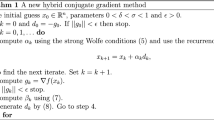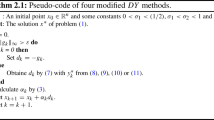Abstract
For the large-scale optimization problems, we propose a new conjugate parameter by modifying the denominator of the Polak–Ribière–Polyak formula, and give its non-negative form. Under the weak Wolfe line search, their corresponding algorithms perform superior to their congener methods, respectively. To guarantee its global convergence, we further introduce a restart condition and a restart direction to improve the proposed method. Under usual assumptions and using the strong Wolfe line search to yielded the step-length, the improved method is sufficient descent and globally convergent. Numerical experiments for the improved method and its comparisons are carried out, and the corresponding numerical results and performance profiles are reported, which showed that the improved method is practicable and efficient for the large-scale optimization problems.






Similar content being viewed by others
References
Andrei N (2008) An unconstrained optimization test functions collection. Adv Model Optim 10(1):147–161
Andrei N (2009) Hybrid conjugate gradient algorithm for unconstrained optimization. J Optim Theory Appl 141:249–264
Cheng WY, Liu QF (2010) Sufficient descent nonlinear conjugate gradient methods with condition. Numer Algor 53(1):113–131
Dai YH, Kou CX (2013) A nonlinear conjugate gradient algorithm with an optimal property and an improved Wolfe line search. SIAM J Optim 23(1):296–320
Dai ZF, Wen FH (2012) Another improved Wei-Yao-Liu nonlinear conjugate gradient method with sufficient descent property. Appl Math Comput 218(14):7421–7430
Dai YH, Yuan YX (1999) A nonlinear conjugate gradient method with a strong global convergence property. SIAM J Optim 10(1):177–182
Dai YH, Yuan YX (2000) Nonlinear conjugate gradient methods. Shanghai Scientific and Technical Publishers, Shanghai
Dolan ED, Moré J (2002) Benchmarking optimization software with performance profiles. Math Program 91:201–213
Dong XL, Han DR, Dai ZF, Li LX, Zhu JG (2018) An accelerated three-term conjugate gradient method with sufficient descent condition and conjugacy condition. J Optim Theory Appl 179:944–961
Fatemi M (2016a) A new efficient conjugate gradient method for unconstrained optimization. J Comput Appl Math 300:207–216
Fatemi M (2016b) An optimal parameter for Dai-Liao family of conjugate gradient methods. J Optim Theory Appl 169(2):587–605
Fatemi M (2017) A scaled conjugate gradient method for nonlinear unconstrained optimization. Optim Methods Soft 32(5):1095–1112
Fletcher R, Reeves CM (1964) Function minimization by conjugate gradients. Comput J 7(2):149–154
Gilbert JC, Nocedal J (1992) Global convergence properties of conjugate gradient methods for optimization. SIAM J Optim 2(1):21–42
Gould NIM, Orban D, Toint PL (2003) CUTEr and SifDec: a constrained and unconstrained testing environment, revisited. ACM Trans Math Soft (TOMS) 29(4):373–394
Hager WW, Zhang HC (2005) A new conjugate gradient method with guaranteed descent and an efficient line search. SIAM J Optim 16(1):170–192
Hager WW, Zhang HC (2013) The limited memory conjugate gradient method. SIAM J Optim 23(4):2150–2168
Hestenes MR, Stiefel E (1952) Method of conjugate gradient for solving linear equations. J Res Natl Bur Stand 49(6):409–436
Jian JB, Han L, Jiang XZ (2015) A hybrid conjugate gradient method with descent property for unconstrained optimization. Appl Math Model 39(3–4):1281–1290
Jiang XZ, Jian JB (2019) Improved Fletcher-Reeves and Dai-Yuan conjugate gradient methods with the strong Wolfe line search. J Comput Appl Math 348:525–534
Khoshgam Z, Ashrafi A (2019) A new hybrid conjugate gradient method for large-scale unconstrained optimization problem with non-convex objective function. Comput Appl Math 38(186):1–14
Kou CX, Dai YH (2015) A modified self-scaling memoryless Broyden-Fletcher-Goldfarb-Shanno method for unconstrained optimization. J Optim Theory Appl 165(1):209–224
Liu JK, Feng YM, Zou LM (2019) A spectral conjugate gradient method for solving large-scale unconstrained optimization. Comput Math Appl 77(3):731–739
Moré J, Garbow BS, Hillstrome KE (1981) Testing unconstrained optimization software. ACM Trans Math Softw 7:17–41
Polak B, Ribière G (1969) Note surla convergence des methodes de directions conjugees. Rev Fr Inf Rech Oper 3(1):35–43
Powell MJD (1984) Nonconvex minimization calculations and the conjugate gradient method, lecture note in mathematics, vol 1066. Springer, Berlin
Saman BK, Ghanbari R (2014) Two modified three-term conjugate gradient methods with sufficient descent property. Optim Lett 8(8):2285–2297
Zhu ZB, Zhang DD, Wang S (2020) Two modified DY conjugate gradient methods for unconstrained optimization problems. Appl Math Comput 373(15):125004
Zoutendijk G (1970) Nonlinear programming, computational methods. In: Abadie J (ed) Integer and nonlinear programming. North-Holland, Amsterdam, pp 37–86
Acknowledgements
The authors wish to thank the two anonymous referees and the editor for their constructive and pertinent suggestions for improving the presentation of the work.
Author information
Authors and Affiliations
Corresponding author
Additional information
Communicated by Paulo J. S. Silva.
Publisher's Note
Springer Nature remains neutral with regard to jurisdictional claims in published maps and institutional affiliations.
This work was supported by NSFC (Grant no. 11771383), the Natural Science Foundation of Guangxi Province (Grant no. 2020GXNSFDA238017), the Research Project of Guangxi University for Nationalities (Grant no. 2018KJQD02) and Innovation Project of Guangxi Graduate Education (gxun-chxzs2019034).
Rights and permissions
About this article
Cite this article
Jiang, X., Jian, J., Song, D. et al. An improved Polak–Ribière–Polyak conjugate gradient method with an efficient restart direction. Comp. Appl. Math. 40, 174 (2021). https://doi.org/10.1007/s40314-021-01557-9
Received:
Revised:
Accepted:
Published:
DOI: https://doi.org/10.1007/s40314-021-01557-9




